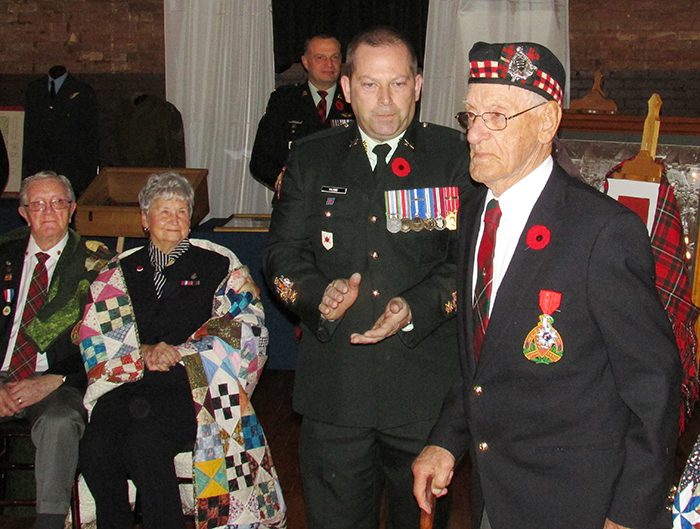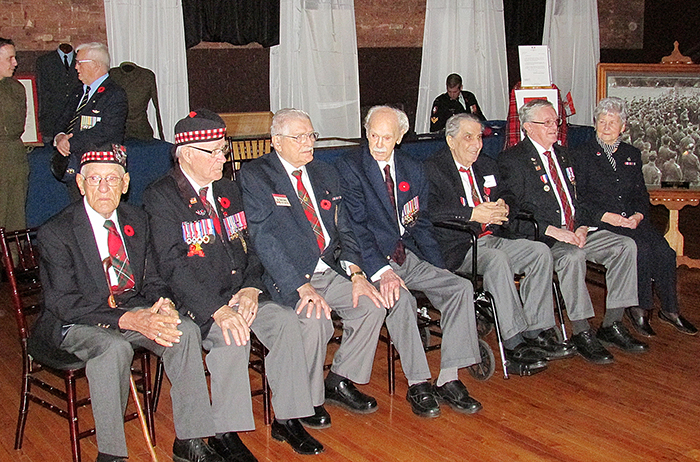
Asked how he came to receive the prestigious French Legion of Honour medal Sunday, Sgt. Glen (Smokey) Embury was brief and to the point.
“I did my job,” was all he would say.
The Blenheim resident was presented with the medal during a Field of Valour dinner that commemorated the battles for Verrieres Ridge and the Falise Pocket in July of 1944.
Chatham Mazda from Chatham Voice on Vimeo.
Some 300 medals are being presented worldwide for distinguished service
As part of the ceremony, seven veterans received personalized quilts listing their names and service information through the Quilts of Valour program.
Receiving quilts, in addition to Sgt. Embury were Capt. Frank Archibald (MC) of the 17th Canadian Field Artillery, Sgt. Roy Hare, Cpl. Charlie Weir, Cpt. Ron Beech, Pte. Arthur Kuderian of the Essex Scottish and LAW Irene Weir of the RCAF.
The Quilts of Valour program has its beginnings in Edmonton in 2006 and became formalized in 2009.
Since that time, volunteer quilters have made than 5,300 quilts across Canada.
Don and Brenda Oliphant, local officials with the volunteer, non-profit initiative, said the quilts are not meant as a badge of honour, but instead as a hug of comfort for all that the veterans have done.
More than 100 persons attended the ceremony at the downtown Chatham Armoury to hear the story of how, despite the worst Canadian losses since Dieppe, allied troops eventually persevered.
The ridge was near the city of Caen, a transportation hub that was the key to the quickest route to the industrial heartland of Germany.
The South Saskatchewans attacked but came under heavy German fire from medium and heavy machine guns, mortars and artillery, with most of their commanders being killed or wounded.
The Essex Scottish assumed the front and were battered as well. The Scottish withstood a fierce counter attack and held on to their position.
At the end of the day, the Essex Scottish were relieved and evacuated from the battlefield, allowing for an artillery barrage and a successful counter attack against the Germans.
The regiment suffered 37 killed, 148 wounded and approximately 133 taken prisoner. It would appear that well over 70% of the Scottish officers had been killed, wounded or captured. The fighting had been on a scale and intensity that exceeded that of the First World War.
Official regimental accounts of those who fought included comments by two members of the regiment.
Sgt. Don Elvy said, “I was proud to fight with those men. I witnessed many brave deeds against overwhelming odds.” John Cross relates, “Too much has been made of this action being unsuccessful. We were up against overwhelming odds, but the soldiers fought on. This was one of the Regiment’s finest days; you couldn’t ask more of men.”
After six days of recovery and reinforcements, the Essex Scottish began preparation for battles of the Falaise Pocket and Falaise Gap, actions that overran German positions, taking a key waterworks facility and forcing a major German retreat across the Seine. In his memoirs, Supreme Allied Commander Gen. Dwight Eisenhower recorded that “the battlefield at Falaise was unquestionably one of the greatest ‘killing fields’ of any of the war areas.” Although it took 10 days to close the Falaise Gap at the Seine River, an estimated 20,000 to 40,000 German soldiers escaped, although they left their vehicles, tanks and heavy weapons behind. Once the Gap had been closed and the Germans in the Falaise Pocket were destroyed, the Seine River was crossed by the Allies opening up the routes to Paris and into Germany.








It was a beautiful event
What a wonderful tribute to those that did so much for our country! We are very proud of our Uncle Frank who fought so valiantly and proudly for our nation,